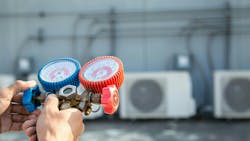Keeping Their Cool: How Refrigerant Service Will Impact HVAC Service
The HVAC industry is ablaze with conversation around incoming refrigerant changes set to transform the way heating, cooling and hot water appliances are made. For contractors and technicians, it can be easy to get lost in the fine print – but what should you really know and be doing now to prepare for these changes?
Let’s start with some context on what’s changing.
What’s driving the changes?
The 1987 Montreal Protocol, an international treaty aimed at protecting the earth’s ozone layer, moved the HVAC industry and several others to swap ozone-depleting substances such as chlorofluorocarbons (CFCs) out in favor of hydrofluorocarbons (HFCs), which are less detrimental to the ozone.
While the ozone has since enjoyed less depletion, HFCs have subsequently been threatening the state of our planet in a whole other way. These potent greenhouse gases have a dangerously high global warming potential (GWP), threatening an impact on the environment the Environmental Protection Agency (EPA) calls “hundreds to thousands of times greater than the same amount of carbon dioxide.”[1]
The American Innovation and Manufacturing (AIM) Act of 2020 mandates the production and consumption of HFCs be reduced by 85% from historic baseline levels by 2036.1 Under new regulation, any appliance or system component with a GWP rating of 700 or higher can no longer be manufactured.
How are manufacturers adapting?
While there are several HFC alternatives that can comply with this regulation, there is a very limited number of refrigerants that are practical for use in HVAC equipment, compliant with AIM Act requirements, and possess a low enough flammability rating to ensure safety.
Should new units experience a refrigerant leak, the unit will de-energize its compressor and energize its fan to dissipate refrigerant vapor, maintaining the safety of the installer, homeowner, and environment.
R-454B has emerged as the refrigerant of choice for Bosch Home Comfort and several other leading OEMs who view it as a worthy alternative to the R-410A refrigerant currently used in many HVAC systems. However, while the R-454B boasts a lower-GWP and non-toxicity, it is also an A2L refrigerant, which means it is mildly flammable – though adherence to normal installation safety precautions makes this an extremely slight risk, which means new trainings and tighter safety precautions will become more staunchly enforced.
How will contractors and installers be impacted?
The day-to-day tasks HVAC professionals manage on the job will go largely unchanged under new regulations, as products manufactured with non-HFC refrigerants will mostly look and feel the same as existing units do – with a few exceptions:
- AIM Act manufacturing requirements mandate the addition of new leak detection sensors to all air source indoor units and to all water source heat pumps with more than 64 ounces of refrigerantss.
- Should new units experience a refrigerant leak, the unit will de-energize its compressor and energize its fan to dissipate refrigerant vapor, maintaining the safety of the installer, homeowner, and environment.
- In-unit cylinders will sport a different look – gray in color with red stripes around the top and marked with icons that indicate the presence of a mildly flammable refrigerant.
The biggest way the AIM Act will impact daily work for professionals is the raised expectations it places upon adherence to safety precautions. There has always been a best practice for charging an HVAC system or responsibly evacuating refrigerants – professionals are required to purge the circuit of a unit with inert gases and ensure the system, vacuum pumps and additional components have been evacuated before beginning any maintenance, for example – but beginning in 2025, the implementation of new regulation will see greater enforcement of these protocols.
More industry-wide emphasis on safety adherence will manifest in multiple ways:
- While completing many of the same procedures with mostly the same tools, the mild flammability of A2Ls will require technicians to add A2L-certified equipment to their kits.
- There will be tighter guidelines from the warehouse to the shop floor governing the handling, transportation, storage and disposal of refrigerants – among them, a requirement that cylinders be transported and stored in a vertical position.
- Technicians will be armed with revamped protective gear in the event they take on leak detection and repair.
As OEMs get closer to perfecting their new HFC-free equipment, technicians should stay on the lookout for new trainings and announcements regarding how evolving details and unit features may impact installation and maintenance procedures.
What about servicing existing equipment?
Equipment manufactured prior to these changes that contains HFCs cannot be retrofitted into an HFC-free machine. Therefore, if your customer has a unit that relies on an HFC refrigerant like R-410A, you will still need to utilize that refrigerant for recharging or refilling the unit, as well as using the right R-410A materials, parts and service procedures during the remaining life of the unit.
As OEMs get closer to perfecting their new HFC-free equipment, technicians should stay on the lookout for new trainings and announcements regarding how evolving details and unit features may impact installation and maintenance procedures.
OEMs will continue making these assets readily available, so technicians need not worry about having access to what they need – the real task here will be making room for both A2L-friendly and traditional HFC-specific tools in your kit and differentiating between both to provide the right service.
Will consumer education be a priority?
The good news is that most consumers aren’t aware of which refrigerants are currently in their machines, if they’re aware of them at all, so they won’t be concerned by this HFC phasedown.
Adhere to the above points on safety and equipment, and you can rest assured the units you install are put in correctly, sized right and work well – and generally, that’s all homeowners care about.
What should contractors be doing now?
The best thing HVAC professionals can be doing now to prepare for the incoming HFC phasedown is to seek out whatever training they can get their hands on. Look out for educational seminars and other resources on the way from your equipment providers exploring all of the necessary know-how and certifications servicepeople will want under their belts before the transition to low-GWP refrigerants is in full effect.
One of these such certifications is the EPA’s Section 608 Technician Certification, commercially available online. If a technician has an existing EPA 608 certification granted earlier for R-410A refrigerant, they can be grandfathered in to be able to purchase A2L refrigerants such as R-454B. If they do not have the EPA 608 certification, they must go through the EPA 608 Certification process, including A2L certification, to purchase A2L refrigerant.
The bottom line? Get your training, uphold safety precautions, and keep your ear to the ground. The exact parameters around this shift are still evolving, and new developments from the EPA and manufacturers alike are emerging all the time.
Syed "Shaz" Shahzer is an Engineering Applications & Training Manager for Bosch Home Comfort in North America. An experienced HVAC industry professional with 12 years of experience, Shaz leads the division with a focus on technical business development and enhancing customer engagement through cutting-edge training initiatives. His career has been marked by significant roles in project management and inside sales, where his contributions have driven business growth and improved operational efficiency.
Shaz earned his Master of Science in Engineering Management from California State Polytechnic University, Pomona, and a Bachelor of Science in Mechanical Engineering from the University of California, Riverside
[1] Environmental Protection Agency (EPA), “Frequent Questions on the Phasedown of Hydrofluorocarbons:” https://www.epa.gov/climate-hfcs-reduction/frequent-questions-phasedown-hydrofluorocarbons#overview
About the Author
Syed Shahzer
Engineering Applications & Training Manager
Syed "Shaz" Shahzer is an Engineering Applications & Training Manager for Bosch Home Comfort in North America. An experienced HVAC industry professional boasting twelve years of experience, Shaz leads the division with a focus on technical business development and enhancing customer engagement through cutting-edge training initiatives. His career has been marked by significant roles in project management and inside sales, where his contributions have driven business growth and improved operational efficiency.
Shaz earned his Master of Science in Engineering Management from California State Polytechnic University, Pomona, and a Bachelor of Science in Mechanical Engineering from the University of California, Riverside.


